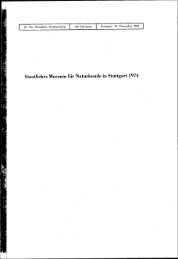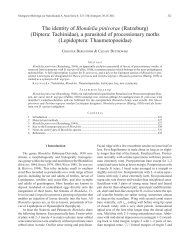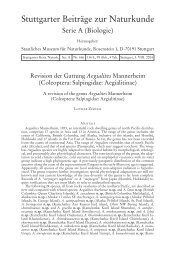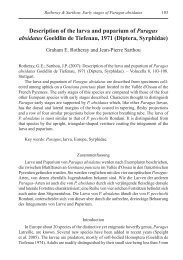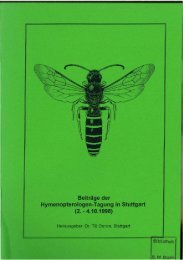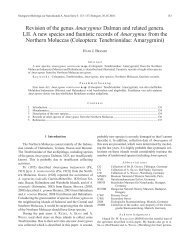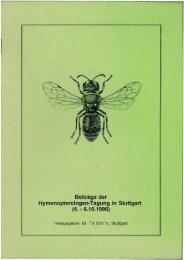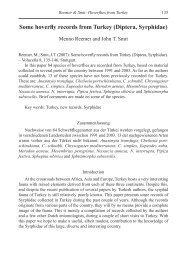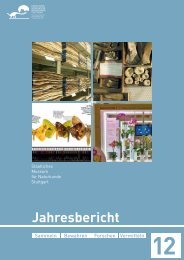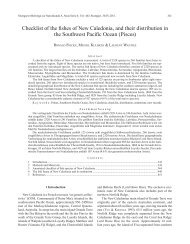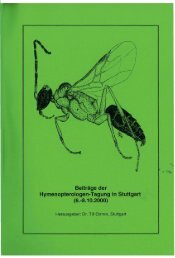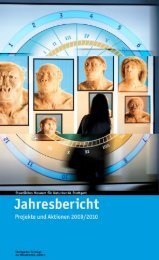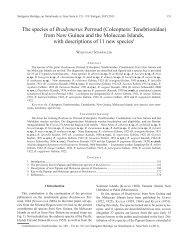Serie A (Biologie) - Staatliches Museum für Naturkunde Stuttgart
Serie A (Biologie) - Staatliches Museum für Naturkunde Stuttgart
Serie A (Biologie) - Staatliches Museum für Naturkunde Stuttgart
Create successful ePaper yourself
Turn your PDF publications into a flip-book with our unique Google optimized e-Paper software.
54 stuttgarter beiträge zur naturkunde Ser. A, Nr. 694pressed. Tibiae in both sexes externally without distinct keels; in males anterior tibiainternally in the distal third with a distinct tooth. Aedeagus see Fig. 121.Diagnosis: To be recognized by the 4-segmented antennal club, by the shapeand punctation of the pronotum, and by the structure of the elytral intervals.Bradymerus merkli n. sp. belongs to the species-group around B. crockerensis n. sp.from Borneo, B. fukiensis from Indochina and Fujian and B. hauseri n. sp. fromW Malaysia with a 4-segmented antennal club and with sexually dimorphic anteriortibiae in males, but cannot be mixed up because of the unique dorsal structure ofpronotum and elytra. See also under B. laoticus n. sp. and B. fouquei n. sp.Bradymerus michihikoi n. sp. (Figs. 55, 123)Holotype (): Central Sulawesi, 38 km SE Pendolo, 1200 m, 10.–11.VII.2001, leg. L.BOLM, SMNS.Paratypes: Sulawesi, 31 km from Palopo, 5.VI.1982, leg. M. TAO, 2 NSMT. – Sulawesi,Sampuraga, 4.XI.1985, leg. M. TAO, 1 NSMT. – Sulawesi, Selatan, Puncak Palopo,2.I.2000, leg. N. OHBAYASHI, 2 ex. CKAO. – Sulawesi, Puncak Palopo, 2.I.2000, leg. M. AN-DO, 1 ex. CKAO.Etymology: Named in honor of MICHIHIKO ANDO (Osaka), son of Dr. KIYOSHI ANDO,one of the collectors of the type series.Description: Dorsal view see Fig. 55, dorsal side blackish without metallicshine, body length 8.8–9.5 mm. Genae not broader than eyes, frons without distinctsupraorbital keels, with deep and extraordinary wide supraorbital furrows. Last 5antennomeres forming a club. Anterior corners of pronotum not protruding, lateralmargin with feeble crenulation, pronotal disc with rough and confluent punctation,pronotal base before scutellum with fine and separate punctation, pronotal discwithout medial impression, between punctures without granules. Alternate elytralintervals 3, 5, 7 with higher, intervals 4, 6, 8 with somewhat lower keels, keels withoutgranules. Tibiae in both sexes externally without distinct keels; in males posteriortibia internally near the tip with a row of distinct long, yellow setae. Aedeagus seeFig. 123.Diagnosis: To be recognized by the deep and extraordinary wide supraorbitalfurrows in both sexes, by the humped pronotum with rough and confluent punctationon the disc and with fine and separate punctation at the base, by keeled elytralintervals and by the shape of the aedeagus. The combination of these characters doesnot occur in any other of the compared species.Bradymerus pseudomalayicus n. sp. (Figs. 62, 126)Holotype (): W Malaysia, Perak, 25 km NE Ipoh, Banjaran Titi Wangsa Mts., Mt. Korbu,1200 m, 1.–15.IV.2000, leg. P. ČECHOVSKÝ, SMNS.Paratypes: Same data as holotype, 1 ex. SMNS. – W Malaysia, Perak, 25 km NE Ipoh,Banjaran Titi Wangsa Mts., Mt. Korbu, 1200 m, 6.–12.V.2001, leg. P. ČECHOVSKÝ, 1 ex. SMNS.– Borneo, Sarawak, Kapit Distr., Rumah Ugap, Sut River, 3.–9.III.1994, leg. J. HORÁK, 3 ex.CSBC, 1 ex. ZSM. – W Borneo (labelled as Borneo occ.), Gunung (labelled as Goenong) Ampar,1897, leg. MULOT, 2 ex. HNHM (labelled by KASZAB as Calabosca sp.).Etymology: Named because of the extreme similarity to Bradymerus malayicus n. sp.from the same area.Description: Dorsal view see Fig. 62, dorsal side dark ferrugineous withoutmetallic shine, body length 5.5–7.3 mm. Genae not broader than eyes, frons withoutdistinct supraorbital keels. Last 4 antennomeres forming a club. Anterior corners ofpronotum not protruding, lateral margin without distinct crenulation but sinuated,



